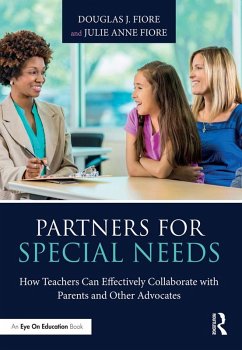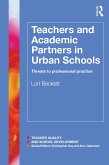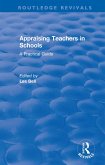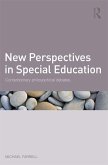Douglas J. Fiore, Julie Anne Fiore
Partners for Special Needs (eBook, ePUB)
How Teachers Can Effectively Collaborate with Parents and Other Advocates
22,95 €
22,95 €
inkl. MwSt.
Sofort per Download lieferbar

11 °P sammeln
22,95 €
Als Download kaufen

22,95 €
inkl. MwSt.
Sofort per Download lieferbar

11 °P sammeln
Jetzt verschenken
Alle Infos zum eBook verschenken
22,95 €
inkl. MwSt.
Sofort per Download lieferbar
Alle Infos zum eBook verschenken

11 °P sammeln
Douglas J. Fiore, Julie Anne Fiore
Partners for Special Needs (eBook, ePUB)
How Teachers Can Effectively Collaborate with Parents and Other Advocates
- Format: ePub
- Merkliste
- Auf die Merkliste
- Bewerten Bewerten
- Teilen
- Produkt teilen
- Produkterinnerung
- Produkterinnerung

Bitte loggen Sie sich zunächst in Ihr Kundenkonto ein oder registrieren Sie sich bei
bücher.de, um das eBook-Abo tolino select nutzen zu können.
Hier können Sie sich einloggen
Hier können Sie sich einloggen
Sie sind bereits eingeloggt. Klicken Sie auf 2. tolino select Abo, um fortzufahren.

Bitte loggen Sie sich zunächst in Ihr Kundenkonto ein oder registrieren Sie sich bei bücher.de, um das eBook-Abo tolino select nutzen zu können.
Learn how to collaborate with parents and special education advocates to ensure student success. This practical book shows you how to navigate the tricky path to meeting special education goals and outcomes. It also provides strategies to help you communicate and partner more effectively with families and specialists.
- Geräte: eReader
- mit Kopierschutz
- eBook Hilfe
- Größe: 1MB
Andere Kunden interessierten sich auch für
![Teachers and Academic Partners in Urban Schools (eBook, ePUB) Teachers and Academic Partners in Urban Schools (eBook, ePUB)]() Lori BeckettTeachers and Academic Partners in Urban Schools (eBook, ePUB)47,95 €
Lori BeckettTeachers and Academic Partners in Urban Schools (eBook, ePUB)47,95 €![The Routledge International Handbook of Teacher and School Development (eBook, ePUB) The Routledge International Handbook of Teacher and School Development (eBook, ePUB)]() The Routledge International Handbook of Teacher and School Development (eBook, ePUB)51,95 €
The Routledge International Handbook of Teacher and School Development (eBook, ePUB)51,95 €![Special Education (eBook, ePUB) Special Education (eBook, ePUB)]() Manny SternlichtSpecial Education (eBook, ePUB)39,95 €
Manny SternlichtSpecial Education (eBook, ePUB)39,95 €![Appraising Teachers in Schools (eBook, ePUB) Appraising Teachers in Schools (eBook, ePUB)]() Appraising Teachers in Schools (eBook, ePUB)31,95 €
Appraising Teachers in Schools (eBook, ePUB)31,95 €![Teacher Education Landscapes in India (eBook, ePUB) Teacher Education Landscapes in India (eBook, ePUB)]() Teacher Education Landscapes in India (eBook, ePUB)42,95 €
Teacher Education Landscapes in India (eBook, ePUB)42,95 €![New Perspectives in Special Education (eBook, ePUB) New Perspectives in Special Education (eBook, ePUB)]() Michael FarrellNew Perspectives in Special Education (eBook, ePUB)49,95 €
Michael FarrellNew Perspectives in Special Education (eBook, ePUB)49,95 €![You Are a Data Person (eBook, ePUB) You Are a Data Person (eBook, ePUB)]() Amelia ParnellYou Are a Data Person (eBook, ePUB)31,95 €
Amelia ParnellYou Are a Data Person (eBook, ePUB)31,95 €-
-
-
Learn how to collaborate with parents and special education advocates to ensure student success. This practical book shows you how to navigate the tricky path to meeting special education goals and outcomes. It also provides strategies to help you communicate and partner more effectively with families and specialists.
Dieser Download kann aus rechtlichen Gründen nur mit Rechnungsadresse in A, B, BG, CY, CZ, D, DK, EW, E, FIN, F, GR, HR, H, IRL, I, LT, L, LR, M, NL, PL, P, R, S, SLO, SK ausgeliefert werden.
Produktdetails
- Produktdetails
- Verlag: Taylor & Francis eBooks
- Seitenzahl: 108
- Erscheinungstermin: 28. November 2017
- Englisch
- ISBN-13: 9781351858236
- Artikelnr.: 50404113
- Verlag: Taylor & Francis eBooks
- Seitenzahl: 108
- Erscheinungstermin: 28. November 2017
- Englisch
- ISBN-13: 9781351858236
- Artikelnr.: 50404113
- Herstellerkennzeichnung Die Herstellerinformationen sind derzeit nicht verfügbar.
Douglas J. Fiore is the author of eight books for educators, including School-Community Relations and Dealing with Difficult Parents, written with Todd Whitaker. Doug has served as a teacher, a principal, a professor, and a consultant, and he most recently served as a provost and vice president for academic affairs.
Julie Anne Fiore has been an educator for thirteen years, spending her most recent year as an Inclusion Intervention Specialist for middle school students. A proponent of partnerships, she insists that teachers engage students, parents, guardians, and those they hire in ensuring student success.
Julie Anne Fiore has been an educator for thirteen years, spending her most recent year as an Inclusion Intervention Specialist for middle school students. A proponent of partnerships, she insists that teachers engage students, parents, guardians, and those they hire in ensuring student success.
About the Authors
Preface
PART I THE PRACTICE OF SPECIAL EDUCATION
Chapter 1 The Development of Special Education Practices
The Legal Environment
Considerations to Ponder
If It's Not Legal, Consider It Illegal
Conclusion
Chapter 2 The Evolution of Instruction
Foundational Perspective of Universal Design for Learning (UDL)
Conclusion
Considerations to Ponder
Reflection Activity Worksheet
Chapter 3 The Individualized Education Plan (IEP) Process
The Exceptional Learner
The Instructional Team: Changing "Me" to "We"
Gathering Evidence: Who, What, When, and Where
Discussing the Data: Who and What
Reviewing the Environment: Where and When
Analyzing the Problem: Why and How
The Eight Components of an IEP
Considerations to Ponder
Conclusion
PART II COLLABORATING AND COMMUNICATING
Chapter 4 Effective Communication and Meeting Strategies
The Communication Process
Nonverbal Communication
Language Barriers
Culture Barriers
Physical Barriers
Perception Checking
Communication Strategies for Meetings
Considerations to Ponder
Conclusion
Chapter 5 "Rule of Three": Working with Professional Advocates
Envisioning the 21st-Century Classroom
Instructional Implications
Considerations to Ponder
"Rule of Three"
Parents: Partners in Language, Communication, and Data Collection
Advocate: Mediator, Negotiator, and Objective Third Party
"Rule of Three": Teacher, Parent, and Advocate
Conclusion
Chapter 6 Advocating as a Parent
Considerations to Ponder
Parent-Teacher Partnering Tips
Advocacy Support
Know the Lingo
Conclusion
Chapter 7 How to Keep Parent Relationships Positive
Rule #1
Pay Attention to the F Word
The Importance of Being Proactive
Parent Involvement at School and at Home
Considerations to Ponder
Conclusion
Afterword
References
Appendix
Preface
PART I THE PRACTICE OF SPECIAL EDUCATION
Chapter 1 The Development of Special Education Practices
The Legal Environment
Considerations to Ponder
If It's Not Legal, Consider It Illegal
Conclusion
Chapter 2 The Evolution of Instruction
Foundational Perspective of Universal Design for Learning (UDL)
Conclusion
Considerations to Ponder
Reflection Activity Worksheet
Chapter 3 The Individualized Education Plan (IEP) Process
The Exceptional Learner
The Instructional Team: Changing "Me" to "We"
Gathering Evidence: Who, What, When, and Where
Discussing the Data: Who and What
Reviewing the Environment: Where and When
Analyzing the Problem: Why and How
The Eight Components of an IEP
Considerations to Ponder
Conclusion
PART II COLLABORATING AND COMMUNICATING
Chapter 4 Effective Communication and Meeting Strategies
The Communication Process
Nonverbal Communication
Language Barriers
Culture Barriers
Physical Barriers
Perception Checking
Communication Strategies for Meetings
Considerations to Ponder
Conclusion
Chapter 5 "Rule of Three": Working with Professional Advocates
Envisioning the 21st-Century Classroom
Instructional Implications
Considerations to Ponder
"Rule of Three"
Parents: Partners in Language, Communication, and Data Collection
Advocate: Mediator, Negotiator, and Objective Third Party
"Rule of Three": Teacher, Parent, and Advocate
Conclusion
Chapter 6 Advocating as a Parent
Considerations to Ponder
Parent-Teacher Partnering Tips
Advocacy Support
Know the Lingo
Conclusion
Chapter 7 How to Keep Parent Relationships Positive
Rule #1
Pay Attention to the F Word
The Importance of Being Proactive
Parent Involvement at School and at Home
Considerations to Ponder
Conclusion
Afterword
References
Appendix
About the Authors
Preface
PART I THE PRACTICE OF SPECIAL EDUCATION
Chapter 1 The Development of Special Education Practices
The Legal Environment
Considerations to Ponder
If It's Not Legal, Consider It Illegal
Conclusion
Chapter 2 The Evolution of Instruction
Foundational Perspective of Universal Design for Learning (UDL)
Conclusion
Considerations to Ponder
Reflection Activity Worksheet
Chapter 3 The Individualized Education Plan (IEP) Process
The Exceptional Learner
The Instructional Team: Changing "Me" to "We"
Gathering Evidence: Who, What, When, and Where
Discussing the Data: Who and What
Reviewing the Environment: Where and When
Analyzing the Problem: Why and How
The Eight Components of an IEP
Considerations to Ponder
Conclusion
PART II COLLABORATING AND COMMUNICATING
Chapter 4 Effective Communication and Meeting Strategies
The Communication Process
Nonverbal Communication
Language Barriers
Culture Barriers
Physical Barriers
Perception Checking
Communication Strategies for Meetings
Considerations to Ponder
Conclusion
Chapter 5 "Rule of Three": Working with Professional Advocates
Envisioning the 21st-Century Classroom
Instructional Implications
Considerations to Ponder
"Rule of Three"
Parents: Partners in Language, Communication, and Data Collection
Advocate: Mediator, Negotiator, and Objective Third Party
"Rule of Three": Teacher, Parent, and Advocate
Conclusion
Chapter 6 Advocating as a Parent
Considerations to Ponder
Parent-Teacher Partnering Tips
Advocacy Support
Know the Lingo
Conclusion
Chapter 7 How to Keep Parent Relationships Positive
Rule #1
Pay Attention to the F Word
The Importance of Being Proactive
Parent Involvement at School and at Home
Considerations to Ponder
Conclusion
Afterword
References
Appendix
Preface
PART I THE PRACTICE OF SPECIAL EDUCATION
Chapter 1 The Development of Special Education Practices
The Legal Environment
Considerations to Ponder
If It's Not Legal, Consider It Illegal
Conclusion
Chapter 2 The Evolution of Instruction
Foundational Perspective of Universal Design for Learning (UDL)
Conclusion
Considerations to Ponder
Reflection Activity Worksheet
Chapter 3 The Individualized Education Plan (IEP) Process
The Exceptional Learner
The Instructional Team: Changing "Me" to "We"
Gathering Evidence: Who, What, When, and Where
Discussing the Data: Who and What
Reviewing the Environment: Where and When
Analyzing the Problem: Why and How
The Eight Components of an IEP
Considerations to Ponder
Conclusion
PART II COLLABORATING AND COMMUNICATING
Chapter 4 Effective Communication and Meeting Strategies
The Communication Process
Nonverbal Communication
Language Barriers
Culture Barriers
Physical Barriers
Perception Checking
Communication Strategies for Meetings
Considerations to Ponder
Conclusion
Chapter 5 "Rule of Three": Working with Professional Advocates
Envisioning the 21st-Century Classroom
Instructional Implications
Considerations to Ponder
"Rule of Three"
Parents: Partners in Language, Communication, and Data Collection
Advocate: Mediator, Negotiator, and Objective Third Party
"Rule of Three": Teacher, Parent, and Advocate
Conclusion
Chapter 6 Advocating as a Parent
Considerations to Ponder
Parent-Teacher Partnering Tips
Advocacy Support
Know the Lingo
Conclusion
Chapter 7 How to Keep Parent Relationships Positive
Rule #1
Pay Attention to the F Word
The Importance of Being Proactive
Parent Involvement at School and at Home
Considerations to Ponder
Conclusion
Afterword
References
Appendix







